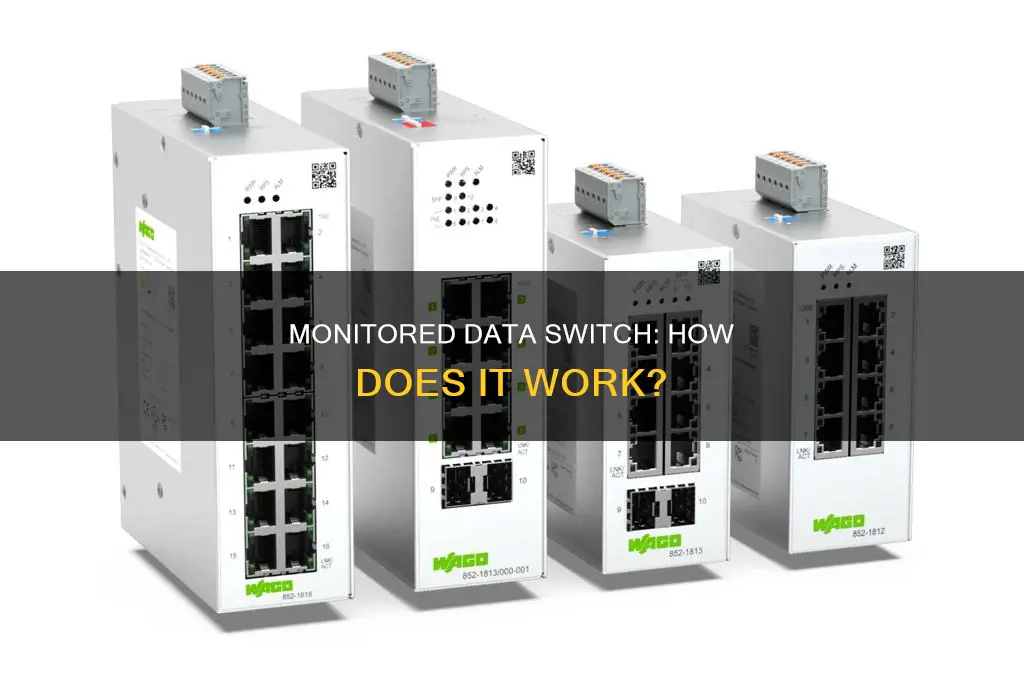
A monitored data switch, also known as a data access switch, tool aggregator, or network packet broker, is a piece of networking hardware that provides a pool of monitoring tools with access to traffic from multiple network links. It enables organizations to centralize traffic monitoring functions and share tools and traffic access between groups. A monitored data switch typically provides 24 to 38 ports in a 1U 19-inch chassis, with higher port density options available for larger implementations. It allows for flexible port mappings, including one-to-one, one-to-many, many-to-one, and many-to-many configurations, providing efficient traffic management. These switches support various internal management interfaces, such as a text-based command-line interface (CLI) and a web browser-based graphical interface, catering to different user preferences and expertise levels.
What You'll Learn

What is a monitored data switch?
A monitored data switch, also known as a data monitoring switch, is a networking hardware appliance that provides a pool of monitoring tools with access to traffic from multiple network links. It is a type of network switch, which connects devices on a computer network and facilitates communication between them.
Data monitoring switches enable organisations to centralise traffic monitoring functions and share tools and traffic access between groups. They can also help to justify tool purchases and simplify the deployment and management of the device itself. These switches typically provide 24 to 38 ports in a 1U 19-inch chassis, with higher port density options expected in the future.
The switches can aggregate monitoring traffic from multiple links, regenerate traffic to multiple tools, pre-filter traffic to offload tools, and direct traffic according to one-to-one and many-to-many port mappings. They can support various port mappings, including one network link to one monitoring tool, one network link to many monitoring tools, many network links to one monitoring tool, and many network links to many monitoring tools.
Data monitoring switches can also filter traffic by Layer 2 to Layer 4 protocol criteria, such as VLAN or IP address, allowing only relevant traffic to be sent to specific tools. This capability can prevent tool oversubscription and facilitate issue identification.
These switches are relatively new, so there are different approaches to hardware and software configurations, with each product offering unique benefits. Some provide different management interfaces, load balancing, and filtering capabilities, while others offer media and data rate conversion, allowing tools to monitor traffic from dissimilar links.
The more advanced data monitoring switches offer enhanced security features, such as access control and port permissions, as well as the ability to manage multiple devices simultaneously from a single interface.
Monitoring Dual Audio Channels in FL Studio
You may want to see also

How does it differ from a network switch?
A monitored data switch is a networking hardware appliance that provides a pool of monitoring tools with access to traffic from a large number of network links. It can aggregate monitoring traffic from multiple links, regenerate traffic to multiple tools, pre-filter traffic to offload tools, and direct traffic according to one-to-one and many-to-many port mappings.
On the other hand, a network switch connects devices within a network (often a local area network, or LAN) and forwards data packets to and from those devices. It operates on the data-link layer, or Layer 2, of the Open Systems Interconnection (OSI) model.
- Functionality: A monitored data switch provides a set of monitoring tools and helps organizations use these tools more efficiently. It enables centralization of traffic monitoring functions and sharing of tools and traffic access between groups. A network switch, on the other hand, connects devices within a network and facilitates the exchange of data packets between them.
- Layer of Operation: A monitored data switch operates at Layer 2 to Layer 4 of the OSI model, allowing filtering of traffic based on protocol criteria. A network switch typically operates at Layer 2 of the OSI model, using MAC addresses to forward data. Some network switches can also operate at Layer 3, incorporating routing functionality.
- Port Mappings: A monitored data switch supports flexible port mappings, including one-to-one, one-to-many, many-to-one, and dynamic many-to-many connectivity. A network switch does not have this flexibility in port mappings and typically connects multiple devices within a LAN.
- Traffic Management: A monitored data switch helps manage and direct traffic by aggregating and regenerating traffic to multiple tools. It can pre-filter traffic to offload tools and prevent tool oversubscription. A network switch manages traffic by forwarding data packets to the intended device within the network, ensuring data reaches its correct destination.
- Application: Monitored data switches are useful for organizations that require efficient traffic monitoring and tool utilization. They are often used in data centers and network operations centers (NOC). Network switches are commonly used in local area networks (LANs) to connect devices and enable communication between them. They are found in homes, small offices, and large enterprises.
- Cost and Complexity: Monitored data switches tend to be more expensive and complex to manage, especially with advanced functionality. Entry-level pricing is high, and they require configuration and management. Network switches can vary in cost and complexity depending on the type (managed, unmanaged, or smart). Unmanaged switches are typically plug-and-play and inexpensive, while managed switches offer more control and customization but are more costly.
In summary, a monitored data switch focuses on providing monitoring capabilities and flexible traffic management, while a network switch primarily connects devices within a network and facilitates the exchange of data packets.
Hilton's Internet Monitoring: What You Need to Know
You may want to see also

What are the benefits of using a monitored data switch?
A data monitoring switch is a networking hardware appliance that provides a pool of monitoring tools with access to traffic from numerous network links. It enables organizations to use their monitoring tools more efficiently, centralize traffic monitoring functions, and share tools and traffic access between groups.
Efficient Use of Monitoring Tools
Monitored data switches allow organizations to make better use of their monitoring tools. They provide a combination of functionalities, such as aggregating monitoring traffic from multiple links, regenerating traffic to multiple tools, and pre-filtering traffic. This helps organizations optimize their monitoring resources and improve overall network efficiency.
Centralized Traffic Monitoring
Monitored data switches enable organizations to centralize traffic monitoring functions. This centralization simplifies network management and provides a comprehensive view of network activity. It also makes it easier to identify and address issues that may impact network performance or security.
Shared Access to Tools and Traffic
These switches facilitate the sharing of monitoring tools and traffic access between different groups within an organization. This promotes collaboration and ensures that resources are utilized effectively across the organization.
Enhanced Security
Monitored data switches offer enhanced security features to protect the network. They provide security settings that can be customized to detect and mitigate potential threats. This is especially important for organizations handling sensitive information or requiring advanced security protocols.
Data Recovery and Redundancy
Monitored data switches often include data recovery solutions and built-in redundancy procedures. These features ensure that data is protected and can be recovered in the event of system failures or disruptions. This adds a layer of resilience to the network infrastructure.
Customization and Configurability
Monitored data switches are highly configurable, allowing IT professionals to tailor them to the specific needs of the network. This customization includes creating virtual networks, setting up virtual LANs, and modifying various settings to optimize network performance and security.
In summary, monitored data switches offer a range of benefits, including improved efficiency in monitoring, centralized traffic management, enhanced security, data recovery options, and the ability to customize and configure the network according to specific requirements. These advantages make them a valuable tool for organizations, especially those with complex or sensitive networking needs.
Performance Monitor: Freeing Up DLLs
You may want to see also

What are the limitations of using a monitored data switch?
A monitored data switch, also known as a data access switch, tool aggregator, or network packet broker, is a networking hardware appliance that provides monitoring tools with access to traffic from multiple network links. It helps organizations centralize traffic monitoring functions, and share tools and traffic access between groups.
While monitored data switches offer several benefits, there are some limitations to consider:
- Cost: Monitored data switches, particularly managed switches, can be expensive, especially for smaller networks with only a few links or tools that need to be instrumented. The cost per port can be high in such cases.
- Complexity: These switches can be complex devices that require configuration and management. They may have cumbersome advanced functionality that is challenging to activate and maintain over time.
- User Interface: The user interface of a monitored data switch can be complex, especially when interconnecting chassis to configure logical systems with a large number of ports. This complexity can limit the usability of the product.
- Command-Line Interface (CLI): Many functions of monitored data switches require the use of a command-line interface (CLI), which can be challenging to navigate for users who are not highly advanced. This can make it difficult to configure filtering and connections without encountering problems.
- Non-Standardization: Different vendors' devices operate and are managed differently, which can create inconsistencies and challenges when trying to standardize processes across different tools.
- Limited Port Density: While monitored data switches typically offer 24 to 38 ports, this may not be sufficient for organizations with high port density requirements or many card slots.
How Monitor Size Impacts Graphics Card Performance
You may want to see also

How does it improve network security?
A data monitoring switch is a networking hardware appliance that provides a pool of monitoring tools with access to traffic from multiple network links. It enables organizations to use their monitoring tools more efficiently, centralize traffic monitoring functions, and share tools and traffic access between groups.
Here's how it improves network security:
Advanced Security Features
Managed data monitoring switches offer advanced security features such as access control and port permissions. These features allow network administrators to control who accesses the network and help monitor for potential security threats. By having this level of control, administrators can prevent unauthorized access and detect any breaches or suspicious activities.
Threat Identification and Protection
The security settings in managed switches can be configured to help identify and protect against potential threats to the network. This proactive approach ensures that the network and its data are safeguarded from malicious activities. By analyzing network traffic, these switches can identify anomalies and take necessary actions to mitigate risks.
Data Recovery Solutions
Managed switches often include data recovery solutions as part of their feature set. This means that in the event of data loss or system failure, the switch can facilitate data recovery processes. This not only improves network security but also ensures business continuity by minimizing downtime and data loss.
Redundancy Procedures
Another advantage of managed switches is their ability to implement redundancy procedures. Redundancy procedures help ensure that the network remains operational even if a failure occurs in one part of the system. By having backup measures in place, managed switches enhance the overall security and reliability of the network infrastructure.
Virtual LANs and Separation of Sensitive Information
Managed switches allow for the creation of virtual LANs (VLANs). This feature enables network administrators to separate devices and traffic containing sensitive information. By segmenting the network, administrators can apply additional security measures to specific areas, thereby increasing protection for critical data.
Filtering and Traffic Direction
Data monitoring switches can filter traffic based on Layer 2 to Layer 4 protocol criteria, such as VLAN or IP address. This capability ensures that only relevant traffic is sent to specific tools or destinations. By directing traffic efficiently, data monitoring switches prevent tool oversubscription and enhance network security by minimizing the exposure of sensitive data.
Overall, data monitoring switches improve network security by offering advanced features, threat identification, data recovery solutions, redundancy, VLAN separation, and efficient traffic filtering and direction. These capabilities help protect sensitive information, detect and mitigate potential threats, and ensure the reliable operation of the network infrastructure.
Switch Toolbars Between Monitors: Easy Steps to Success
You may want to see also
Frequently asked questions
A monitored data switch is a networking hardware appliance that provides a pool of monitoring tools with access to traffic from a large number of network links.
Managed switches are a necessity for larger organisations or any network that stores sensitive information. They can be configured to meet the needs of a network and include features such as redundancy procedures and data recovery solutions. Unmanaged switches, on the other hand, are simple plug-and-play devices with no settings to configure. They are ideal for small businesses or organisations with limited network traffic.
Monitored data switches enable organisations to use their monitoring tools more efficiently, centralise traffic-monitoring functions, and share tools and traffic access between groups. They also support remote monitoring and control, saving time and expenses.
Some examples of monitored data switch tools include network packet brokers, net tool optimisers, and distributed filter taps.
Monitored data switches can be expensive, complex to configure and manage, and non-standard across different vendors. They may also require advanced technical expertise to activate and maintain certain functionalities.







